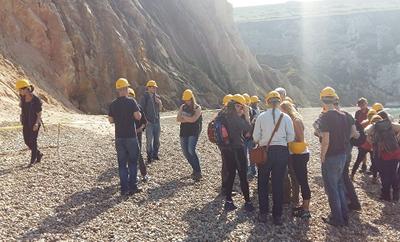The first cohort of NEXUSS postgraduates arrives in Southampton

We reported the success of the NERC / EPSRC funding bid for NEXUSS back in October 2015 and since then, the team has been recruiting the first intake of postgraduates. This cohort received their induction during the week of 19 September and have now fully embarked upon their experience in the use of smart and autonomous observing systems (SAOS) in environmental science. As part of induction week the students attended sessions led by SAOS experts and environmental scientists from across the NEXUSS partnership, which includes the British Antarctic Survey, Heriot-Watt University, National Oceanography Centre, Scottish Association for Marine Science, University of East Anglia. The students toured the excellent SAOS facilities at the National Oceanography Centre andelsewhere in the University of Southampton, and got to experience the mission control of a major marine deployment of SAOS technologies. Here are some of their reactions:-

NEXUSS PhD student, Rob Blackwell from British Antarctic Survey: We hear so much in the media about Unmanned Aerial Vehicles (UAVs), but who knew that sophisticated underwater gliders are measuring and monitoring our oceans? NEXUSS is a fantastic opportunity to explore this amazing technology. I really enjoyed my induction at Southampton, an opportunity to see the state-of-the-art facilities at both the National Oceanographic Centre and Southampton University. We visited the Marine Autonomous and Robotic Systems (MARS) facility at a particularly exciting time; they were in the middle of a deployment in association with the Royal Navy and were able to show us real time operational maps. It was also remarkable to see a 3D printed aircraft at Boldrewood. The rapid manufacturing capability means that engineers can go from an idea to a prototype in just a matter of hours. It wasn't all work. We enjoyed a day out on the Isle ofWight and found some interesting fossils and even dinosaur footprints. I'm a computer scientist and I'm looking forward to the challenge of improving communications with underwater gliders. I'm hoping to use state-of-the-art machine learning technology to allow real time reporting of ecosystem metrics. This feels like an exciting time for underwater gliders as we move beyond prototypes and into larger scale deployments with important real-world applications in oceanography and marine science.

NEXUSS PhD student, Ryan Scott: I thought that the induction was brilliant. It was a great introduction into the potential uses of gliders and it made me very excited to get started. My area of research will be to investigate whether underwater gliders can be used to quantify horizontal mixing in the west Antarctic. Horizontal ocean mixing is an important mechanism for delivering heat to the glaciers and ice shelves in this region. However, the processes involved are not well understood due to the patchiness of measurements from profilers. Deploying autonomous gliders will hugely increase the number of measurements collected and consequently could vastly improve our understanding of these processes. With sea levels rising and climate change becoming more and more relevant, a greater understanding of these processes could improve future climate models. This is the reason I have chosen this NEXUSS PhD.